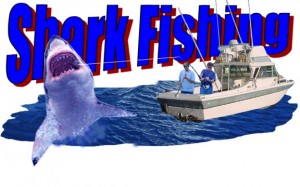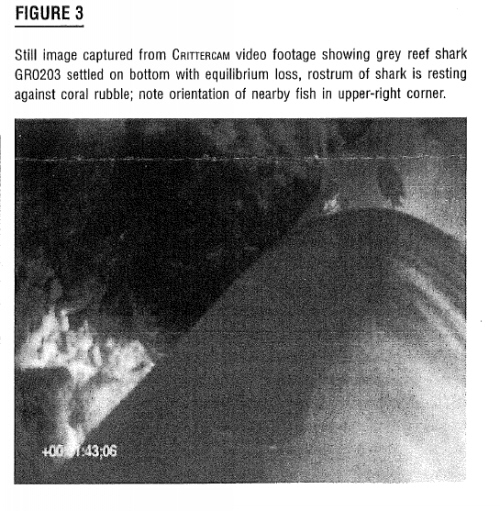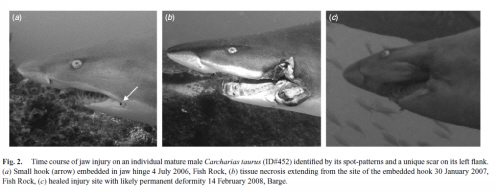In the wake of the new Marianas Islands shark conservation law, a debate has been raging on the shark listservs. The law wouldn’t have been possible without support from several local recreational fishermen- people who often take tourists catch-and-release fishing for sharks.
“When I heard of your effort in Hawaii to ban the sale,trade and possession of shark fins I knew if the CNMI was to follow someone with inside connections to the fishing world there had to espouse it and grow it. They do not like being told what to do from outsiders. I was not an outsider, and I fished alongside two of the very top level fishermen who happened to be upper level politicians whom I respected. Rep. Diego Benevente was one of them. I spoke with him and asked him to introduce a bill which replicated Hawaii’s law, and he did so. I kept constant contact with him and his staff in the effort to see this bill become law.”- Captain William McCue

Many shark conservationists support catch-and-release fishing, claiming that it allows fishermen the thrill of catching a large animal without killing it. Captain McCue reports that in the last 20 years:
“I’ve caught over 300 sharks in the that time a killed four- and if you include spiny dogfish it’s caught well over 2000 sharks and still killed only four- two of which were promptly eaten.”
However, some (such as “My Sunset Rendezvous” author Ila France Porcher) claim that even when a shark is released, the stress from being caught often still causes long-term damage or even death.
“As a shark ethologist, I have personally witnessed sharks who were hooked and fought, and who broke the line, emerge from the ordeal with a jaw so damaged that they lost weight and died over the following weeks or months. A high fraction of sharks caught suffered this fate, and they suffered greatly as a result of this enjoyable passtime pursued by sports fishermen. It would be great news to hear that you switched from a blood sport to a sport that celebrates the life that still remains in our seas, such as diving and photography.” – Ila France Porcher
The arguments are getting increasingly heated, and both sides are relying primarily on personal observations instead of peer-reviewed science:
“I was referring to my eye witness experiences of sharks I knew over many years….The fact that people are simply not there witnessing and recording what happens to the sharks that you harm should not be considered proof that your practices are not harmful and do not result in the death of the shark later. All animals are delicate organisms, and cannot withstand substantial injury without supportive care. They die. I hope that you will reform your practices and change your ways”- Ila France Porcher
With all due respect to both Captain McCue and Ila, who are both experts in their respective fields, most people are not convinced by personal observations. Peer-reviewed science is something that I find far more convincing. As it turns out, there has been a fair amount of research done of the subject of post-release mortality in sharks.
It is admittedly challenging to study this subject. Most shark research is done from a boat, and once the shark is put back into the ocean, we can’t see it anymore. So how can we determine what happens to it?
There are a few ways to do this. One is to measure the blood chemistry of the animal while it is still on the research vessel. We know from previous captive studies what a healthy range for metrics like blood pH are, and we know that “exercise” from capture stress alters these metrics. If the shark’s blood pH is within a healthy range when it is released, we can infer that the shark lived. This method isn’t perfect because we don’t know what a healthy range is for all species, and because it doesn’t account for things like infection.
Another method involves tracking the shark with acoustic or satellite telemetry. If it is still moving, it’s still alive. Similarly, a “Crittercam” can be attached to the shark to monitor it’s post-release behavior. These methods are extremely expensive and require larger sharks (they don’t make cameras small enough for some species).

Some researchers have begun testing the effects of fishing capture and release on captive animals. Several sharks are placed in captivity and acclimated for days or weeks. Then, researchers “catch” them using standard fishing gear and release them back into their tank. Their post-release behavior can be easily observed in this manner.
The final method is to encounter the sharks you released again at a later date. Though easier said than done, this is the theory behind mark-recapture studies. Additionally, many species of sharks have a small home range, allowing SCUBA divers to track them down.

These methods have been applied to a variety of different shark species all over the world. Not surprisingly, whether or not catch-and-release fishing is harmful to a shark depends on a lot of different factors. Some species, like the sandbar shark, are incredibly hardy. I’ve interacted with nearly 400 sandbar sharks for my Masters research, and each one that we released swam away quickly as soon as it hit the water. Blood chemistry research confirms that sandbars are unusually good at recovering quickly from anaerobic exercise. Also, telemetry studies show that Atlantic sharpnose sharks have nearly 90% survivability after release.
Others, like the gummy shark, are relatively fragile. A captive fishing study demonstrated that being caught in a net and released quickly resulted in nearly 70% mortality in this species.
As for Ila’s point about hook injuries? This, too, varies by species. Researchers studying critically endangered Grey Nurse Shark of Australia (what we Americans call sand tiger sharks) found that at one of the few areas where grey nurses are protected, between 29% and 52% of all identified individuals had hook injuries, which varied in severity. However, only 3% of blue sharks off the coast of Long Island had hook injuries (though most injuries were severe).
In summary, although research in this field is ongoing, it seems that both Ila and Captain McCue are both right (and both wrong). Though it varies tremendously by species and location, catch-and-release fishing appears to be more harmful than Captain McCue claimed and less harmful than Ila claimed.
However, as someone else in the listserv discussion pointed out, cooperation with recreational fishermen is essential for shark science and conservation.
“To stop any waste less slaughter, education is the way forward, so anglers that used to kill sharks get involved in tagging and research projects. Competitions can be become a vital source of data, enabling us to learn about migratory routes, stock fluctuations and dynamics etc etc. I help run the Scottish shark tagging programme; we use voluntary shark anglers. We are 50% financed by Scottish Natural Heritage, which is a Scottish Government agency. The analysis of the data will be used to input into shark management plans, implementation of nursery areas, establish commercial closed seasons, MPA’s etc. We put the anglers through a training course as the successful release of the shark is paramount. Our “codes of best practise” have been downloaded and translated into 7 different languages. Organisations like the UK Shark Trust support our work as they realise we can supply the data that no one else can. Peer pressure has changed so much in the UK and anglers are ostracised for killing any shark”- Ian Burret
Ian is absolutely correct. There are a lot more fishing vessels than research vessels, so working with fishermen allows scientists to collect a great deal more data. Tournaments like the Guy Harvey Ultimate Shark Challenge are extremely helpful to scientists.
Additionally, catch-and-release fishing helps make keeping sharks alive valuable. Shark finners claim that they should be allowed to kill sharks because doing so provides jobs. If keeping them alive to catch them for sport and release them also provides jobs, this takes away from the finners’ argument.
In an ideal world, people would appreciate sharks by SCUBA diving with them, and we would stop activities such as catch-and-release fishing which harm some sharks. However, in the real world, I remain a big supporter of catch-and-release shark fishing. It’s a lot better than catch-and-kill-for-no-reason shark fishing.
Bansemer, C., & Bennett, M. (2010). Retained fishing gear and associated injuries in the east Australian grey nurse sharks : implications for population recovery Marine and Freshwater Research, 61 (1) DOI: 10.1071/MF08362
BRILL, R., BUSHNELL, P., SCHROFF, S., SEIFERT, R., & GALVIN, M. (2008). Effects of anaerobic exercise accompanying catch-and-release fishing on blood-oxygen affinity of the sandbar shark (Carcharhinus plumbeus, Nardo) Journal of Experimental Marine Biology and Ecology, 354 (1), 132-143 DOI: 10.1016/j.jembe.2007.10.011
Borucinska, J., Kohler, N., Natanson, L., & Skomal, G. (2002). Pathology associated with retained fishing hooks in blue sharks, Prionace glauca (L.), with implications for their conservation Journal of Fish Diseases, 25 (9), 515-521 DOI: 10.1046/j.1365-2761.2002.00396.x
Donaldson, M., Arlinghaus, R., Hanson, K., & Cooke, S. (2008). Enhancing catch-and-release science with biotelemetry Fish and Fisheries, 9 (1), 79-105 DOI: 10.1111/j.1467-2979.2007.00265.x
Frick, L., Reina, R., & Walker, T. (2010). Stress related physiological changes and post-release survival of Port Jackson sharks (Heterodontus portusjacksoni) and gummy sharks (Mustelus antarcticus) following gill-net and longline capture in captivity Journal of Experimental Marine Biology and Ecology, 385 (1-2), 29-37 DOI: 10.1016/j.jembe.2010.01.013
Gurshin, C., & Szedlmayer, S. (2004). Short-term survival and movements of Atlantic sharpnose sharks captured by hook-and-line in the north-east Gulf of Mexico Journal of Fish Biology, 65 (4), 973-986 DOI: 10.1111/j.0022-1112.2004.00501.x
Hight, B., Holts, D., Graham, J., Kennedy, B., Taylor, V., Sepulveda, C., Bernal, D., Ramon, D., Rasmussen, R., & Lai, N. (2007). Plasma catecholamine levels as indicators of the post-release survivorship of juvenile pelagic sharks caught on experimental drift longlines in the Southern California Bight Marine and Freshwater Research, 58 (1) DOI: 10.1071/MF05260
Morgan, A., & Carlson, J. (2010). Capture time, size and hooking mortality of bottom longline-caught sharks Fisheries Research, 101 (1-2), 32-37 DOI: 10.1016/j.fishres.2009.09.004
Skomal, G., Lobel, P., & Marshall, G. (2007). The Use of Animal-Borne Imaging to Assess Post-Release Behavior as it Relates to Capture Stress in Grey Reef Sharks, Carcharhinus amblyrhynchos Marine Technology Society Journal, 41 (4), 44-48 DOI: 10.4031/002533207787441999

Excellent write-up. Please note I wrote that I killed four sharks- not that four sharks died in total. Only God knows how many sharks died later from the actions of my boat catching them. Many shark fishermen use “J” hooks and many use circle hooks- and the type of hook used is a huge determinant of the severity of injuries to the animal caught by rod and reel. Circle hooks have been universally found to cause much less injury to released fish, and have been espoused by nearly all areas where recreational fishers intend to release the fish. Shark fishing at this time is behind that curve however, and needs to push towards using circle hooks when shark fishing in my humble opinion. I certainly hope more recreational and traditional fishers will work with those that wish to protect the oceans great life, and feel it is my personal duty to do so.
Circle hooks can and should be an industry standard.
Thank you for your thoughtful analysis, David.
I would like to add to my comments quoted above that these same “personal observations” were in-depth enough to establish the gestation period of the species I was studying, (On the gestation period of the blackfin reef shark, Carcharhinus melanopterus, in waters off Moorea, French Polynesia. Mar Bio 146: 1207-1211), and to provide the first evidence of cognition in sharks, which was presented to the International Symposium on cognition held at the Max Planck Institute in Tuzting, Germany, in November 2003 by Professor Arthur A. Myrberg Jr. of the University of Miami.
My observations were recorded in detail in the course of a seven year ethological study which did reveal much scientific evidence that was peer reviewed and scientifically accepted.
After doing further research in the course of my work, I wrote a treatise to debunk the myth that fish don’t feel pain, which was published in Beyond Blue Magazine. It can be found, references included, on my website in the section on sharks headed “articles.”
The moral question regarding the ethics of inflicting severe damage to the jaws of sentient creatures, for profit and amusement, remains unanswered.
The full account of my study is written down in my 640 page book, “My Sunset Rendezvous–Crisis in Tahiti.”
As a diver, the number of Grey Nurse sharks which I’ve seen with external hooks is distressing (not to mention other fish). My dive club once had a talk from NSW Fisheries and Wildlife (government department) in which the presenter described GNS autopsies and concluded that more hooks were internal than external. My conclusion is that fishing must be excluded from shark aggregation sites.
What is this archaic thrill of watching other creatures suffer??? Roman circusses, bull fights, the knitters sitting as closely as possible in front of the guillotines enjoying the sight of people being decapitated…
Fishing sharks to tag them for scientific purposes – yes, albeit with shark-friendly hooks, and trying to cause as little harm as possible.
But catching sharks and release them, for “pleasure”, is nothing but brutal and erhically unacceptable.
I fully agree with Ila France Porcher. Hooking sharks and subsequently release them often results in serious injuries, stress, and sometimes death.
Having seen MANY, too many tiger sharks with grossly deformed jaws, I am completely at a loss to find any justification whatsover for “recreational” catch-and-release shark fishing.
As Ila said, recreational shark fishermen should dive / snorkel with sharks. If they had some basic sensitivity for animals, they would then stop hunting sharks, and would realize that inflicting great pain to them for ‘fun’ is simply immoral.
Amen.
“My conclusion is that fishing must be excluded from shark aggregation sites”
In many cases, fishing is already illegal at shark aggregation sites. By definition, sharks aggregate at these sites from all over. Just because an injured shark is at one of these aggregation sites does not mean that the injury occurred there.
Unfortunately this isn’t the case in many of the areas I”m talking about! It’s not uncommon to see fishing within these areas (and marine park sanctuary zones, but that’s another story).
Excluding fishing from aggregation sites is a first step, but I believe it will help.
This one is tricky, but I think the author did a good job addressing the issue.
Yes, it is true that even catch-and-release is stressful to the hooked animal, even after release. Lasting injury and death are possibilities. I’m not going to get into the idea of “pain and suffering” at the risk of anthropormorphisizing something that isn’t fully understood.
But I think we can all agree that catch-and-release is infinitely better than catch-and-kill. At least the sharks are given a chance of surviving, and more importantly, the people involved have decided that a live shark is better (and yes, worth more) than a dead one. Changing people is a lot harder than changing policy.
I support catch-and-release. A lot of shark research is dependent on fisheries data, from both commercial and recreational sources; and it is the science that will lead to change, not ethical or moral debates. As sad as it is, ethic and morals don’t usually factor into lawmaking.
One last point. While I agree that ideally there would be no fishing at all, I certainly wouldn’t want everyone to take up shark diving. That’s a whole other issue with its own set of problems.
How harmful it is depends on how it’s done. Ways to reduce harm include: 1) Use barbless hooks and plan to remove them. 2) they can be removed with a long de-hooker; I use these: http://www.dehooker4arc.com/. 3) Use circle-hooks or never let the shark run with the bait; fish with reel locked to prevent swallowing and maximize jaw-hooking. 4) Use heavy line, and use good line.
Thinking about and planning for clean releases helps reduce harm to the animals.